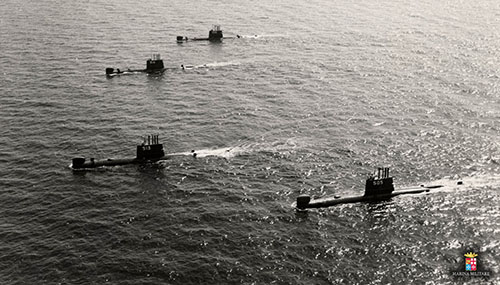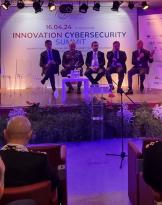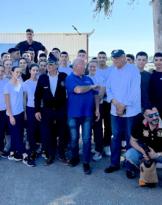Ten years ago, after more than thirty years as a Navy in the service of the country, the Toti submarine reached the "Leonardo Da Vinci" National Science and Technology Museum in Milan and began its second life.
On the occasion of the tenth anniversary, the Museum has organized a series of initiatives open to the public from 5 to 8 December. Among the many activities scheduled, on 7 December, there will be former submariners who have sailed on the boat over the thirty years of operational use. On the same day, the Radio Amateurs Italian Sailors Association will set up a radio station - with a special name (II2IGTO, international acronym of Toti) - to make connections with various radio stations located in the area. Radio links will be activated with the Sauro submarine kept at the Galata museum, the Naval Technical Museum of La Spezia and with many radio amateurs who will broadcast from the major cities where the Toti stopped over the years of service (Augusta, Taranto, Cagliari, Messina).
History
The submarines of the Navy (find out more) have a great and ancient tradition, together with their crews, one of the most glorious families of the Armed Force (find out how to become part of it). The Toti, the first boat built in Italy since the war, was built at Italcantieri in Monfalcone; assembly began on 11 April 1965. Launched on 12 March 1967, it was delivered to the Navy on 22 January 1968. The boat was designed with anti-submarine characteristics (NATO acronym SSK-Submarine, Submarine Killer) and being the progenitor gave the name to the class, completed in two years by the submarines Dandolo, Mocenigo and Bagnolini.
The Enrico Toti has participated in many operational missions and exercises, navigating over the course of his life for more than 27.000 engine hours and covering 137.000 miles (254.000 kilometers). It was led by 34 commanders and 10 engine managers.
Technical features
 The Toti was capable of reaching a maximum depth of 300 meters. 46 meters long, just under 5 meters wide, and over 7 meters high; powered by two Fiat diesel engines, capable of delivering 1.040 hp, plus a 900 hp electric motor, it could reach speeds of 10 knots on the surface and 14 knots underwater. The submarine was equipped with an armament consisting of 4 torpedo tubes of 553 mm in the bow for electric wire-guided torpedoes with self-searching head A184 and 4 reserve torpedoes. The Toti class was composed of small boats, suitable for the Mediterranean and characterized by advanced technical systems. For a hunter submarine like the Toti, the "eyes" were indispensable: a device on board was capable of emitting and receiving ultrasonic waves thanks to the hydrophonic-ecogoniometric system, which was able to locate underwater objects with extreme precision.
The Toti was capable of reaching a maximum depth of 300 meters. 46 meters long, just under 5 meters wide, and over 7 meters high; powered by two Fiat diesel engines, capable of delivering 1.040 hp, plus a 900 hp electric motor, it could reach speeds of 10 knots on the surface and 14 knots underwater. The submarine was equipped with an armament consisting of 4 torpedo tubes of 553 mm in the bow for electric wire-guided torpedoes with self-searching head A184 and 4 reserve torpedoes. The Toti class was composed of small boats, suitable for the Mediterranean and characterized by advanced technical systems. For a hunter submarine like the Toti, the "eyes" were indispensable: a device on board was capable of emitting and receiving ultrasonic waves thanks to the hydrophonic-ecogoniometric system, which was able to locate underwater objects with extreme precision.
The submarine housed a crew of 4 officers, 22 non-commissioned officers and sailors; generally inside the men were distributed in two alternating teams, respecting shifts that included four hours of guard and four of rest. During particularly demanding and dangerous maneuvers, the whole crew remained on alert even for many consecutive hours.
On 30 June 1999, the Toti, once active service ended, was transferred to the Museum of Science and Technology in Milan, where it has been kept since 14 August 2005.

The long journey
The Enrico Toti arrived in the Lombard capital at the end of a long and complicated journey that began from the port of Augusta, in Sicily (April 5, 2001) and then went up the Adriatic and then the Po to the river port of Cremona. (6 May 2001) where he was stationed until 8 August 2005 and thanks to the work of the 2nd Pontieri Regiment of Piacenza he was picked up and transported, by land, to the Milanese museum.
The entry into the city of the convoy for special transport required the closure of a section of the eastern ring road. Along the way to reach the National Museum of Science and Technology, everything that might be a hindrance to the passage was demolished and dismantled: sidewalks, flowerbeds, road signs and guardrails. To overcome immovable obstacles and to prevent possible ground subsidence, mobile bridges made of steel panels and cables were used.
During transport a huge 120 ton crane and four small 55 tons cranes were used; the convoy was pulled by two carts with 240 wheels.
The submarine's motto is: Win at any cost!
Happy Birthday Toti!













